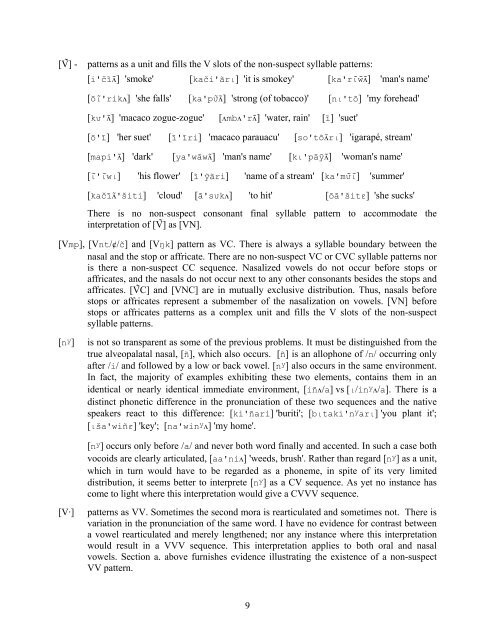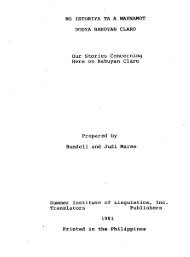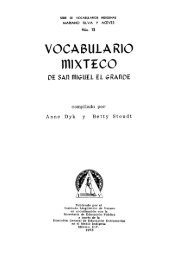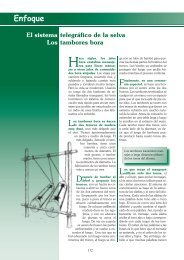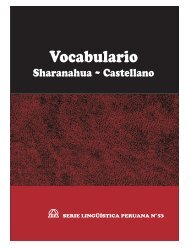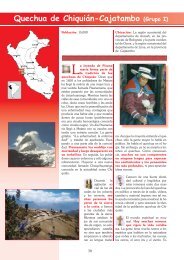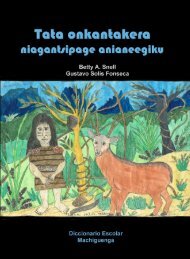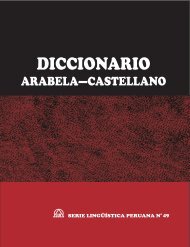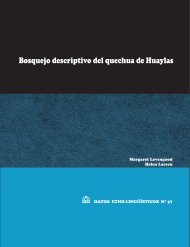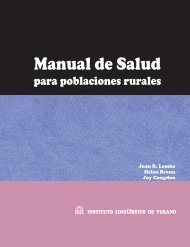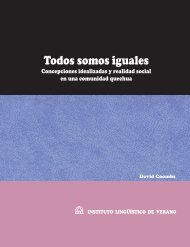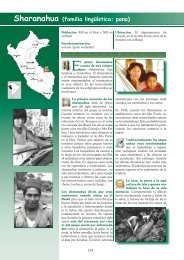A Phonemic Analysis of the Apurinã Language
A Phonemic Analysis of the Apurinã Language
A Phonemic Analysis of the Apurinã Language
You also want an ePaper? Increase the reach of your titles
YUMPU automatically turns print PDFs into web optimized ePapers that Google loves.
[Ṽ] -patterns as a unit and fills <strong>the</strong> V slots <strong>of</strong> <strong>the</strong> non-suspect syllable patterns:[i'čĩʌ̃] 'smoke' [kači'ãrι] 'it is smokey' [ka'rι̃w̃ʌ̃] 'man's name'[õι̃'rikʌ] 'she falls' [ka'pυ̃ʌ̃] 'strong (<strong>of</strong> tobacco)' [nι'tõ] 'my forehead'[kυ'ʌ̃] 'macaco zogue-zogue' [ʌmbʌ'rʌ̃] 'water, rain' [ĩ] 'suet'[õ'ĩ] 'her suet' [ĩ'ĩri] 'macaco parauacu' [so'tõʌ̃rι] 'igarapé, stream'[mapi'ʌ̃] 'dark' [ya'wãwʌ̃] 'man's name' [kι'pãỹʌ̃] 'woman's name'[ι̃'ι̃wι] 'his flower' [ĩ'ỹãri] 'name <strong>of</strong> a stream' [ka'mυ̃ι̃] 'summer'[kačĩʌ̃'šiti] 'cloud' [ã'sυkʌ] 'to hit' [õã'šitε] 'she sucks'There is no non-suspect consonant final syllable pattern to accommodate <strong>the</strong>interpretation <strong>of</strong> [Ṽ] as [VN].[Vmp], [Vnt/ȼ/č] and [Vŋk] pattern as VC. There is always a syllable boundary between <strong>the</strong>nasal and <strong>the</strong> stop or affricate. There are no non-suspect VC or CVC syllable patterns noris <strong>the</strong>re a non-suspect CC sequence. Nasalized vowels do not occur before stops oraffricates, and <strong>the</strong> nasals do not occur next to any o<strong>the</strong>r consonants besides <strong>the</strong> stops andaffricates. [ṼC] and [VNC] are in mutually exclusive distribution. Thus, nasals beforestops or affricates represent a submember <strong>of</strong> <strong>the</strong> nasalization on vowels. [VN] beforestops or affricates patterns as a complex unit and fills <strong>the</strong> V slots <strong>of</strong> <strong>the</strong> non-suspectsyllable patterns.[n y ] is not so transparent as some <strong>of</strong> <strong>the</strong> previous problems. It must be distinguished from <strong>the</strong>true alveopalatal nasal, [ñ], which also occurs. [ñ] is an allophone <strong>of</strong> /n/ occurring onlyafter /i/ and followed by a low or back vowel. [n y ] also occurs in <strong>the</strong> same environment.In fact, <strong>the</strong> majority <strong>of</strong> examples exhibiting <strong>the</strong>se two elements, contains <strong>the</strong>m in anidentical or nearly identical immediate environment, [iñʌ/a] vs [ι/in y ʌ/a]. There is adistinct phonetic difference in <strong>the</strong> pronunciation <strong>of</strong> <strong>the</strong>se two sequences and <strong>the</strong> nativespeakers react to this difference: [ki'ñari] 'buriti'; [bιtaki'n y arι] 'you plant it';[ιša'wiñε] 'key'; [na'win y ʌ] 'my home'.[n y ] occurs only before /a/ and never both word finally and accented. In such a case bothvocoids are clearly articulated, [aa'niʌ] 'weeds, brush'. Ra<strong>the</strong>r than regard [n y ] as a unit,which in turn would have to be regarded as a phoneme, in spite <strong>of</strong> its very limiteddistribution, it seems better to interprete [n y ] as a CV sequence. As yet no instance hascome to light where this interpretation would give a CVVV sequence.[V·]patterns as VV. Sometimes <strong>the</strong> second mora is rearticulated and sometimes not. There isvariation in <strong>the</strong> pronunciation <strong>of</strong> <strong>the</strong> same word. I have no evidence for contrast betweena vowel rearticulated and merely leng<strong>the</strong>ned; nor any instance where this interpretationwould result in a VVV sequence. This interpretation applies to both oral and nasalvowels. Section a. above furnishes evidence illustrating <strong>the</strong> existence <strong>of</strong> a non-suspectVV pattern.9


